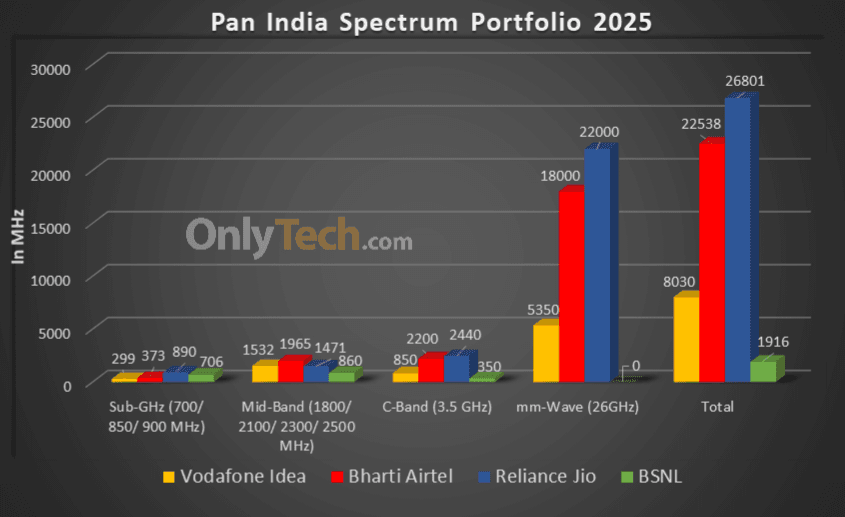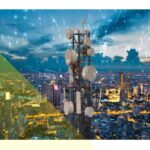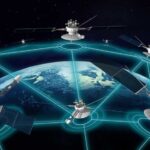Spectrum is for telecommunication what jet fuel is for aviation. Spectrum is a range of electromagnetic frequencies or airwaves that telecom companies use for establishing a connection between a cell tower and a mobile phone. The bandwidth of this spectrum is directly proportional to the speed of a wireless data network (since more data can be transmitted simultaneously through a broader data pipeline). In contrast, the frequency is inversely proportional to the coverage (since lower frequencies penetrate better through physical barriers and thus have wider coverage).
The spectrum holding data sheet embedded in this article represents the current spectrum holdings of all active telecom operators across all frequency bands across all 22 telecom circles along with their liberalisation status and expiry dates. All figures represented are in MHz. The value mentioned in the bracket beside the frequency at the base of each sheet is the band number where ‘B’ stands for 4G LTE band whereas ‘n’ stands for the corresponding 5G NR band.
The spectrum shown under BSNL and Aircel in white is reserved for the respective operators but has not yet been officially allotted to them.
Spectrum Liberalisation:
Spectrum was administratively allocated to operators in each of the 22 licensed service areas or circles prior to 2010, this spectrum is called non-liberalised and can only be used for 2G services whereas all airwaves allotted post-2010 have been through a Spectrum Auction where operators have paid the market discovered price and this spectrum is called liberalised and can be used for any technology platform 2G/3G/4G/5G. Alternatively, operators may choose to liberalise their administratively allotted spectrum by paying the market-discovered price to DoT on a pro-rata basis for the remaining validity of the spectrum.
Paired and Unpaired spectrum:
Spectrum may be paired or unpaired, bands 1/3/5/8/28 are all paired where one set of frequencies is used for uplink whereas another distinct set of frequencies is used for downlink known as Frequency-division duplexing (FDD), whereas bands 40/41/78/258 are unpaired where both uplink and downlink happens in the same set of frequencies separated by the time of uplink and downlink known as Time-division duplexing (TDD).
List of Indian FDD Bands:
| 4G LTE band | 5G NR band | Uplink frequency range (MHz) | Downlink frequency range (MHz) | Bandwidth for telecom (MHz) | Block size (MHz) |
|---|---|---|---|---|---|
| B1 | n1 | 1939-1979 | 2129-2169 | 40×2 | 5×2 |
| B3 | n3 | 1710-1780 | 1805-1875 | 70×2 | 0.2×2 |
| B5 | n5 | 824-844 | 869-889 | 20×2 | 1.25×2 |
| B8 | n8 | 890-915 | 935-960 | 25×2 | 0.2×2 |
| B28 | n28 | 723-733/ 738-748 | 778-788/ 793-803 | 20×2 | 5×2 |
List of Indian TDD Bands:
| 4G LTE band | 5G NR band | Frequency range (MHz) | Bandwidth for telecom (MHz) | Block size (MHz) |
|---|---|---|---|---|
| B40 | n40 | 2300-2380 | 80 | 10 |
| B41 | n41 | 2535-2555/ 2615-2655 | 60 | 10 |
| – | n78 | 3300-3670 | 370 | 10 |
| – | n258 | 24250-27500 | 3250 | 50 |
Spectrum caps:
A spectrum cap dictates how much spectrum a particular operator can hold in a circle for a specific band. There is a 40% cap for Sub-GHz spectrum in the 700/850/900 MHz bands combined, a 40% cap for Mid-Band spectrum in the 1800/2100/2300/2500 MHz bands combined, a 40% cap for the C-Band spectrum of 3300-3670 MHz and a 40% cap for the mm-Wave spectrum bands of 24.25-27.5 GHz. The current spectrum caps are denoted in the spectrum chart.
Overall spectrum holdings of operators (in MHz):
| Operator/Holding | Jio | Airtel | Vi | BSNL |
|---|---|---|---|---|
| Sub-GHz | 890 | 373.2 | 298.8 | 706 |
| Mid Band | 1470.8 | 1964.9 | 1531.6 | 860 |
| C-Band | 2440 | 2200 | 850 | 350 |
| mm-Wave Band | 22000 | 18000 | 5350 | 0 |
| Total | 26,800.8 | 22,538.1 | 8,030.4 | 1,916 |
Spectrum sharing/trading/leasing guidelines:
- Telecom operators holding CMTS/UASL/UL licenses can enter into a Spectrum-Sharing agreement with each other so long as both parties hold liberalised spectrum in the same band in the same circle. Spectrum sharing is possible only on a Pan LSA level in block sizes defined by DoT and only after one year of an operator acquiring the spectrum.
- Telecom operators holding CMTS/UASL/UL licenses can enter into a Spectrum-Trading agreement with each other so long as the spectrum being sold is liberalised. Trading of spectrum is possible only on a Pan LSA level in block sizes defined by DoT and only after two years of an operator acquiring the spectrum.
- Telecom operators may enter into a Spectrum-Leasing agreement only with Enterprises holding a Captive Non-Public Network (CNPN) license and not with each other. The lease may be limited to any geographic area within the LSA and for any duration mutually agreed upon by both parties. A CNPN licensee can lease spectrum from multiple operators within an LSA.
Note: We update this chart in real-time to ensure it is always up to date with the latest changes in spectrum holding. Certain human errors might have crept in during the manual compilation of the data, any mistakes/ rectification can be brought to the Team’s notice through the comments section below.








@esmail will BSNL only get additional 5 Mhz in b1 expect Delhi (10 Mhz b3) and RJ (5 Mhz b5) for 4G services ? Also what about b41 holdings , will that also be used for 4G ? Last query if BSNL only launch 4G on b1 and b41🤞🏽 how will they manage good coverage ?
I try to refrain from commenting much about BSNL since it’s very unpredictable, the government reserves spectrum for them but doesn’t assign it. And when they do it’s not clear whether they will hold it for long or surrender it for a refund or ask for a free extension. So coming to your last query yes even if they launch 4G on 5 MHz block of band 1 and 20 MHz block of band 41 it will still give better speeds than their 3G network and yes it will be sufficient since it is a network used only by ppl living in remote areas which are not served by Jio and Airtel. It’s not like they are competing head on with the two giants, since no person with a sound mind would opt for BSNL 4G if he/she has Jio or Airtel 4G coverage in their area, so the load on the network won’t be an issue.
They have not assigned but still BSNL in Andhra is using two 5MHz B1 blocks for 3G and 4G and in one place they have 10MHz B1 deployed for LTE too just checked on last Sunday. I can share pics with EARFCN and frequency details too
Everything is allowed for BSNL, if a private operator were to be found using spectrum that wasn’t allotted to them by DoT, they would have had to pay hefty fines, but if BSNL does it it’s okay. Even the 900 MHz that it is currently using for 2G services had expired 2 years back in 2020 and in the latest spectrum holding disclosure by DoT before the auction it said that the government is still in the process of considering the re-allocation of the 900 MHz spectrum to BSNL which means they have been using it for free since the last 3 years. That is why I have shown the holding in white rather than assigning it a colour denoting expiry.
I thought its liberised spectrum.
Anything about RCom resolution?
Yesterday something happened. RIL subsidiary has agreed to takeover Anil Ambani assets as ETTelecom.
Those are passive infrastructure things like towers and fiber, not active infrastructure like spectrum holdings.
Esmail Sir, Big fan of yours. Learnt so many things by just reading your comments/replies. I have a very important query. Will be grateful if you could kindly answer that. Thanks in advance.
When the smartphone or feature phone is lying idle (not using any internet, calls or sms) but when latched to the network (2G/3G/4G), does the phone actively use any spectrum or other resources of the telcos (Airtel, Jio etc.)? And is it same for all technologies – 2G, 3G, 4G (esp 4G/VoLTE) or is it different for each? Simply put, does it cost telcos anything even if a customer is not actively using the connection and is lying just idle in the phone without any usage (esp in 4G/VoLTE)?
Good question Shamit, I’ll try and explain it in simple words to make it easy to understand.
As far as the data component is concerned, a phone connected to the network but in standby mode does not consume any data bandwidth actively unless there is some background task running and mobile data is turned on, in which case few data packets may be uplinked or downlinked occassionally.
As far as the voice component is concerned even though there is no direct consumption of the operator’s network resources, a phone in standby mode connected to network still counts as an active connection to the tower or cell-site serving a particular area. To understand the implication this has on 2G and 3G network, you need to understand the concept of cell-breathing in self optimising networks (SON). This is a dynamic load balancing technology, whereby a cell site when connected to too many devices, reduces it’s emitting power thus reducing its coverage radius so that instead of giving substandard service to all devices it delivers quality service to devices closer to the tower while offloading devices further away from the tower to let them get served by another cell site that is lesser congested.
Now if you consider a phone of an inactive subscriber who doesn’t recharge his connection but just keeps the sim idle in a feature phone or smartphone which is switched on and connected to the network and he is close by to a cell tower, and another phone which is of an active connection but is very far from the tower, the active connection phone may not be able to make or receive calls since inactive connections which are closer to the tower are adding to the congestion and overloading the tower. This is why Airtel and Vi keep cleaning up inactive numbers from their network.
This cell-breathing does not effect LTE/VoLTE networks, which is why for a very long time Jio was not bothering with deactivating inactive numbers. Now you may wonder why then did they recently start deactivating these numbers? The answer to that lies in the average revenue per user (ARPU) figures. Inactive numbers don’t contribute to revenue and end up diluting the ARPU which reflects baldy on a telco’s balance sheet, which is why to improve the ARPU Jio cleaned up the inactive numbers.